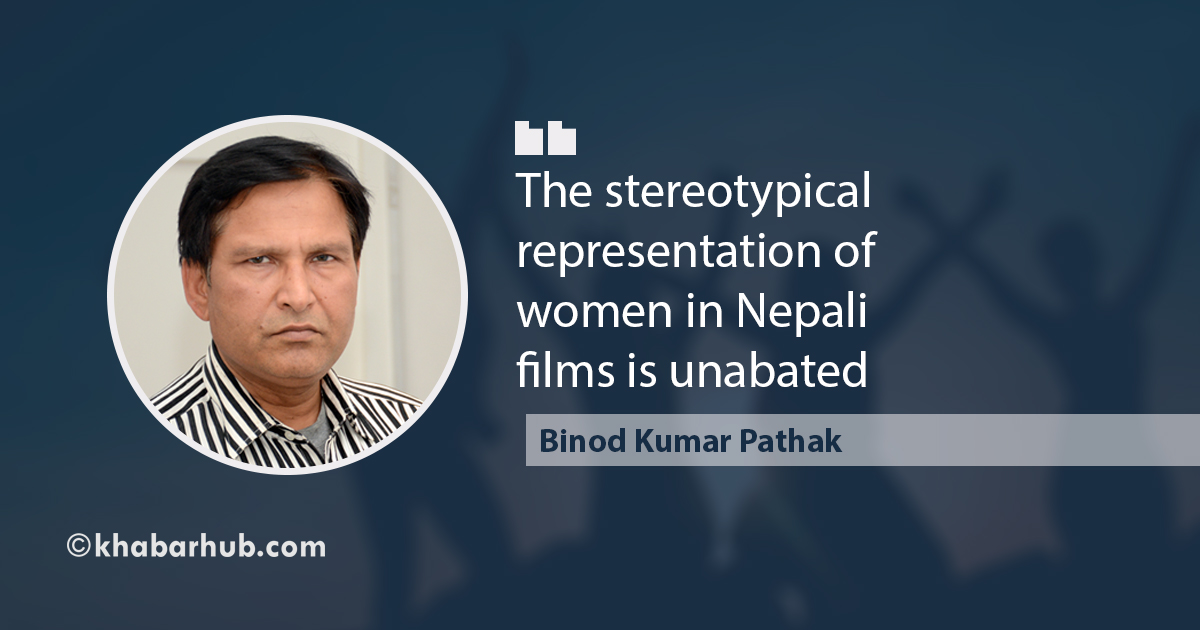Nepali films are often accused of maintaining and strengthening the traditional divide between male and female roles to the extent of promoting sexism in daily life affairs. Male characters are portrayed as dominant, independent and aggressive. They are expected to always protect women and rescue her from difficult situations of life as the latter cannot come out of it on the strength of personal power and strength.
Female characters in Nepali films have to be naïve and victims of different life situations desperately looking for being rescued by a powerful male. The stereotypical representation of women in Nepali films is continuing unabated even in the twenty-first century as latest releases are a testimony to this fact. This kind of portrayal of women in ‘restrictive’ roles in contemporary Nepali films extends to every aspect of life including human sexuality and eroticism.
What kind of negotiation or trading is this by a woman for another woman in exchange of love and sex from a man?
Reecha Sharma, a Nepali actor, raised an alarm on the negative portrayal of woman in super-hit film Chhaka Panja (2016) in which a woman director Deepa Shree Niraula allowed a reprehensible scene lowering down the prestige of a woman where a female character agrees to marry a man on the condition that he gets to slap his wife every night. What kind of negotiation or trading is this by a woman for another woman in exchange of love and sex from a man?
Misogynistic one-liners in Nepali films go a long way in objectifying woman’s identity and her sexuality in utterly bad taste which reflects on the screen during the course of dance and song sequence on the screen. Dialogues such as ‘Girls are like chewing gum – sweet at the beginning but dull at the end’ from Dreams (2016), ‘Your breasts are like footballs‘ in Captain (2019) and ‘If a woman goes and works what about my manhood’ in Saili (2019) openly highlight gender stereotypes and sexist remarks deeply entrenched in Nepalese society.
The portrayal of a woman in mainstream films in a patriarchal society is aimed at providing a pleasurable visual experience for men.
In light of the above observations, it is apt here to use psychoanalytic theory to understand the representation of women in films rooted in patriarchal values. Laura Mulvey (born 15 August 1941, a British feminist film theorist) in her essay, ‘Visual Pleasure and Narrative Cinema‘ (written in 1973 and published in 1975) demonstrates how the patriarchal unconscious of society shapes our film watching experience by applying psychoanalytic theory in her analysis.
The portrayal of a woman in mainstream films in a patriarchal society is aimed at providing a pleasurable visual experience for men. Motion picture camera through the eyes of writer and director creates a cinematic gaze which is always masculine that represents the mental desires of the male subject placing everything else in a film, including female characters, as objects. Male gaze operates by means of the identification produced with the male hero, and through the use of the camera.
Scopophilia functions on an axis of the passive/active vault in which the man is always on the active ‘to-look’ gazing side and the woman on the passive ‘to-be-looked-at’ side.
According to Mulvey, pleasures by watching films are derived by fulfilling the mental desires of a male subject with the help of objectification of the image followed by the identification with it. The male gaze is either ‘voyeuristic’ — seeing a woman as image to be looked at or ‘fetishist’ — seeing a woman as a substitute for ‘the lack’, the underlying psychoanalytic fear of castration. Freud terms the objectification of the image as scopophilia — the pleasure derived from subjecting someone to one’s gaze. Scopophilia functions on an axis of the passive/active vault in which the man is always on the active ‘to-look’ gazing side and the woman on the passive ‘to-be-looked-at’ side.
The Nepalese film industry must break their own cocoon in which women characters are held back lacking autonomy and independence to express themselves. In dialogues, they speak and the camera that rolls down present them as if they are programmed puppets of their masters.









Comment